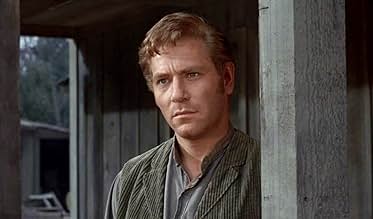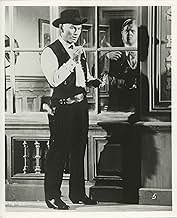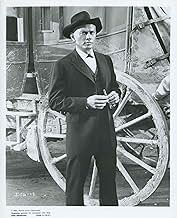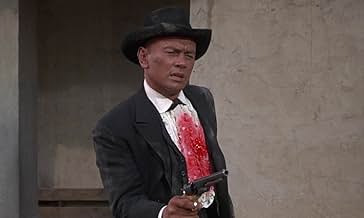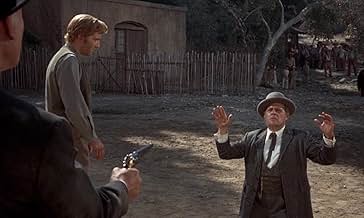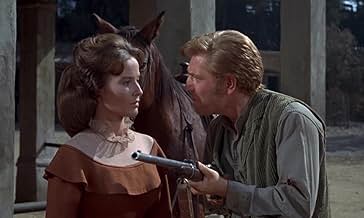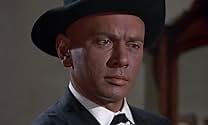Un veterano Confederado regresa a su rancho en Nuevo México y encuentra a su prometida casada con un soldado de la Unión, vecinos hostiles y su tierra vendida por un banquero que lo quiere m... Leer todoUn veterano Confederado regresa a su rancho en Nuevo México y encuentra a su prometida casada con un soldado de la Unión, vecinos hostiles y su tierra vendida por un banquero que lo quiere muerto.Un veterano Confederado regresa a su rancho en Nuevo México y encuentra a su prometida casada con un soldado de la Unión, vecinos hostiles y su tierra vendida por un banquero que lo quiere muerto.
- Dirección
- Guionistas
- Elenco
- Manuel
- (as John Alonzo)
Opiniones destacadas
A confederate solider Matt Weaver returns back to his small town after the civil war to find out his home has been sold by the dominating town boss Sam Brewster. Causing a ruckus, Brewster hires the interestingly mysterious gunfighter Jules Gaspard d'Estaing to take care of Brewster; however Jules gets caught up in the devious shades of a town run by corrupt figures.
The way the story pans out is thoughtfully projected and the framework delivers it in an unconventional manner with some psychological interplays. The way the steely protagonist uses the situation to gain what he wants and hand out much needed justice within the shameful town simply holds you there. It's literally chatty, but never does it outstay its welcome. A sternly defined Brynner is outstanding (as the camera magnetically follows him around) and likewise is a booming Hingle. When the action/shoot outs occur they're rather sparse, but toughly staged despite its obvious studio bound sets.
AS the movie progresses it's slowly revealed that the Union leaning town is not what it seems to be. Pat Hingle plays a politician very common for 30 years after the Civil War, adept at what they called "waving the bloody shirt." Just demagogue away at who did what and where during the war and ignore the current issues both social and economic.
During the course of The Magnificent Seven, Yul Brynner's Chris Adams is referred to as a Cajun. Here he's given a proper Cajun name of Jules D'Estaing and when his secret is revealed, a whole lot of people in that town have to confront their own prejudices.
Makes for worthwhile viewing.
d'Estaing's drunken rampage through the town came as a shock; the place must have been typical of many of the postbellum period, and its racism, venality and corruption as portrayed in the film didn't seem to justify a hired assassin's rage. It would have been better had d'Estaing been exposed to more overt racism than a patronising suggestion that he finds accommodation in a Mexican establishment.
No great surprises in the ending, but again it wasn't convincing when the Anglo-Americans united with the Mexicans in a gesture of respect.
Take away Brynner and this would have been an extremely average Western.
The acting is all over the board in this one, as well. Brynner's performance can't be faulted; he's his usual simmering, silent presence, but seems miscast in a role which could have been quite interesting if it weren't so poorly-written. Janice Rule seems confused in her role as Ruth Adams (and well she should be, forced to serve as the love interest between--count them--three men, all trying to kill each other at some point or another), and spends most of it looking vaguely sad and disinterested, and Pat Hingle is neither evil enough nor serious enough to make a compelling villain. Clifford David fares better as the perpetually angry Crane, and George Segal, as the unfortunate Matt Weaver, is just about the only member of the cast that seems to have any idea what he's doing. The rest of the townsfolk are a mixture of clichés and stereotypes that make it seem as though Yul Brynner mistakenly wandered onto the set of "Blazing Saddles." Brynner's presence, and the multi-layered, operatic scale of the plot might warrant repeat viewings, and the film should be credited for trying to tackle weighty issues of morality and racism, but ultimately "Gunfighter" misses its mark. The classic mantra in storytelling is "show, don't tell," and this film doesn't do that, rendering what should have been a very good movie into a very mediocre one.
¿Sabías que…?
- TriviaThe Psicosis (1960) house set on the Universal back lot was the home for the character "Sam Brewster".
- ErroresOne of the Union infantry veterans in the town wears crossed rifles on his kepi. But the cross rifles insignia was not adopted for infantry until after the Civil War. The crossed rifles are what infantry wore during the post Civil War Indian wars. Rather, infantry wore a bugle on their kepis or bummers cap, and as the year is 1865 and as this is a Union infantry veteran from the Civil War, he should be wearing the bugle insignia and not the crossed rifles insignia.
- Citas
Sam Brewster: Is your name Jewel?
Hotel Owner: The hotel register....
Jules Gaspard d'Estaing: My name is
[d'Estaing writes his name on a blackboard]
Sam Brewster: Jewels...Gasperd...Die-es-ting
Jules Gaspard d'Estaing: Jules...soft j, silent s...Gaspard...silent d...d'Estaing...just a touch of dipthong.
- Créditos curiososOpening credits prologue: NEW MEXICO TERRITORY - 1865
- ConexionesReferenced in Una questione d'onore (1966)
Selecciones populares
- How long is Invitation to a Gunfighter?Con tecnología de Alexa
Detalles
- Fecha de lanzamiento
- País de origen
- Idioma
- También se conoce como
- Poziv revolverasu
- Locaciones de filmación
- Productoras
- Ver más créditos de la compañía en IMDbPro
Taquilla
- Presupuesto
- USD 1,800,000 (estimado)


